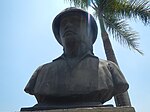Diego Silang
This articleneeds additional citations forverification.(December 2016) |
Diego Silang | |
|---|---|
| Governor of theIlocos British Philippines | |
| In office 1762–1763 | |
| Personal details | |
| Born | Diego Silang y Andaya December 16, 1730 Aringay,Pangasinan,Captaincy General of the Philippines,Spanish Empire(now Aringay,La Union) |
| Died | May 28, 1763(aged 32) Bantay,Ilocos,Captaincy General of the Philippines, Spanish Empire |
| Manner of death | Assassination |
| Spouse | |
Diego Silang y Andaya(Spanish:[ˈdjeɣosi.ˈlaŋg];December 16, 1730 – May 28, 1763) was a Filipino revolutionary leader who allied withBritishforces to overthrowSpanishrule in the northernPhilippinesand establish an independentIlocanostate.His revolt was fueled by grievances stemming from Spanish taxation and abuses, and by his belief in self-government, that the administration and leadership of theRoman Catholic Churchand government in the Ilocos be invested in trained Ilocano officials. His wife, theItnegGabriela Cariño,took on leadership of his revolt after his assassination.
Historical accounts
[edit]"Diego de Silang, a Filipino, very quick and artful, and who being a native of Manila [ie island of Luzon], spoke the Spanish language well, began to revolutionize this province, by telling his countrymen, that in order to maintain the Catholic faith, and to preserve the country in obedience to the King, it was requisite to join together and arm against the Spaniards, and deliver them up to the English, against whom they had no means of resistance. These specious arguments made an impression on the minds of the chiefs, and many plebeians, particularly those of Vigan, which is the capital of the province, and residence of the Bishop. The seduced Filipinos presented themselves armed, and demanded that theAlcaldeshould give up the staff of government, and deposit it in the hands of the Vicar-general. The majority advised the Alcalde to defend himself against this attack; but instigated by his fears, or swayed by the opinion of injudicious friends, he resigned the command to the Vicar-general, and with no inconsiderable share of hazard of his life, effected his escape from the province. Emboldened by their success in this instance, the rebels demanded of the Bishop elect, Señor Ustariz, a Dominican, an exemption from the tribute, declaring that they acted justifiable in deposing the Alcalde. The Bishop pledged himself to lay beforeSeñor Andaa favourable representation of their claims; but Silang being determined on acquiring the command, and little satisfied with what he had done, began to collect troops for more extensive operations."
Joaquín Martínez de Zúñiga (1805)[1]
Early life
[edit]Diego Silang was born on December 16, 1730 inAringay,which was then a part ofPangasinan.Today, this area is encompassed by present-dayCabaor Aringay inLa Union.His father wasPangasinense,while his mother wasIlocano.He was baptized on January 7, 1731 inViganin the then-undivided province ofIlocos.[2]There, young Diego worked as a messenger for a local Castilian priest. Bright, passionate, and fluent in Spanish, he ferried correspondence from the Ilocos to Manila; journeys that gave him his first glimpse of colonial injustice and that planted the seed of rebellion.
Revolt
[edit]
Spain allied with France during theSeven Years' War,in opposition to Great Britain. The British in response sought to weaken the Spanish Empire. The seizure of Manila by British naval forces in October 1762, and the subsequent surrender of the Spanish Philippines to Britain during theBritish occupation of the Philippines,inspired uprisings in the farthest north of Ilocos Norte and Cagayan, where anti-Spanish sentiments festered. Though Silang initially wanted to replace Spanish functionaries in the Ilocos with native-born officials and volunteered to head Ilocano forces on the side of the Spanish, desperate Spanish administrators instead transferred their powers to the Catholic Bishop ofNueva Segovia,who rejected Silang's offer.
Assassination
[edit]
Diego Silang was killed on May 28, 1763 by one of his friends, a Spanish-Ilocano mestizo named Miguel Vicos, whom church authorities paid to assassinate Silang with the help of Pedro Becbec.[3]He was 32 years old.
Legacy
[edit]
After Silang's death, his Spanish-Itnegmestizawife, Gabriela Silang, took command of the revolt and fought courageously. The Spanish sent a strong force against her. She was forced to retreat to what is nowAbra.Gabriela led her troops towards Vigan but was driven back. She fled again to Abra, where she was captured. Gabriela and her men were summarily hanged on September 20, 1763, she being hanged the last.
In popular culture
[edit]- Portrayed byGardo Versozain the 1995 TV SeriesBayaniin this episode "Diego Silang: Ang Sulat".
- Portrayed byJC Tiusecoin the 2013 TV series,Indio.
- Portrayed byMarc AbayainWagasin this episode "Wagas: Diego at Gabriela Silang".
Notes
[edit]- ^Martinez de Zuñiga (1814).Historical View of the Philippine Islands Vol. 2.Translated by Maver, John. T. Davison. p. 212-214.
- ^National Historical Institute (1996).Historical Calendar (1521-1969).Manila: The National Historical Institute. p. 5.ISBN971-538-097-2.
- ^Lamberto Gabriel,Ang Pilipinas: Heograpiya, Kasaysayan, at Pamahalaan.1997ISBN971-621-192-9
References
[edit]- Zaide, Gregorio F. (1984).Philippine History and Government.National Bookstore Printing Press.
- Rebecca Ramilo Ongsotto, Reena R. Ongsotto:Philippine History Module-based Learning.Rex Bookstore Inc, 2. Auflage 2003,ISBN971233449X,p. 109 (online copy,p. 109, atGoogle Books)
- C. Duka:Struggle for Freedom.Rex Bookstore Inc, 2008,ISBN9789712350450,p. 103 (online copy,p. 104, atGoogle Books)
